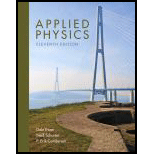
Velocity is
- a. the distance traveled per unit of time
- b. the same as speed
- c. direction of travel and distance traveled per unit of time
- d. only the direction of travel
Choose the correct option from the given options.
Answer to Problem 1RQ
The correct option is “
Explanation of Solution
Given data:
From the given data, it is required to define the term velocity.
Formula used:
Write the expression for the velocity of an object as follows.
Here,
Description:
The velocity is a vector parameter and it has both magnitude (quantity) and direction. From equation (1), the object’s velocity is stated as the distance travelled by an object per unit time in a particular direction.
Speed is a scalar parameter and it has only quantity (magnitude). Speed is stated as the distance travelled by the object per unit time irrespective of the direction.
Therefore, from the given options, the option c is an adequate option.
Since, the option a describes about the speed of the object and it does not describes the object’s velocity, the option a is the incorrect answer.
Since, the speed and velocity are different parameters, option b is the incorrect answer.
Since, the velocity not only describes about the direction (describes both quantity and travel’s direction), option d is the incorrect answer.
Conclusion:
Hence, the correct option is “
Want to see more full solutions like this?
Chapter 4 Solutions
Applied Physics (11th Edition)
Additional Science Textbook Solutions
Modern Physics
Physics for Scientists and Engineers with Modern Physics
Lecture- Tutorials for Introductory Astronomy
Conceptual Integrated Science
University Physics (14th Edition)
Conceptual Physical Science (6th Edition)
- One mile is equal to 1,609 m. Express this distance in kilometers and in centimeters.arrow_forwardThe average distance between Earth and the Sun is 1.51011m . (a) Calculate the average speed of Earth in its orbit (assumed to be circular) in meters per second. (b) What is this speed in miles per hour?arrow_forwardAcceleration may result from what? (2.3) (a) an increase in speed (b) a decrease in speed (c) a change in direction (d) all of the precedingarrow_forward
- An object is dropped from a height of 75.0 m above ground level. (a) Determine the distance traveled during the first second. (b) Determine the final velocity at which the object hits the ground. (c) Determine the distance traveled during the last second of motion before hitting the ground.arrow_forwardA ship sets sail from Rotterdam, The Netherlands, heading due north at 7.00 m/s relative to the water. The local ocean current is 1.50 m/s in a direction 40.0° north of east. What is the velocity of the ship relative to the Earth?arrow_forwardA sandal is dropped from the top of a 15.0-m-high mast on a ship moving at 1.75 m/s due south. Calculate the velocity of the sandal when it hits the deck of the ship: (a) relative to the ship and (b) relative to a stationary observer on shore. (c) Discuss how the answers give a consistent result for the position at which the sandal hits the deck.arrow_forward
- An object is dropped from a height of 75.0 m above ground level. (a) Determine the distance traveled during the first second. (b) Determine the final velocity at which the object hits the ground. (c) Determine the distance traveled during the last second of motion before hitting the ground.arrow_forwardAn airplane leaves Chicago and makes the 3000-km trip Los Angeles in 5.0 h. A second plane leaves Chicago one-half hour later and arrives in Los Angeles at the same time. Compare the average velocities of the two planes. Ignore the curvature of Earth and the difference in altitude between the two cities.arrow_forwardAn object is in motion when it undergoes a continuous change of ___. (2.1)arrow_forward
- A police car waits in hiding slightly off the highway. A speeding car is spotted by the police car doing 40 m/s. At the instant the speeding car passes the police car, the police car accelerates from rest at 4m/s2 to catch the speeding car. How long does it take the police car to catch the speeding car?arrow_forwardAn average person sneezes about three times per day. Estimate the worldwide number of sneezes happening in a time interval approximately equal to one sneeze.arrow_forwardWhich is true of an object with uniform velocity? (2.2) (a) It has constant speed. (b) It has constant direction. (c) It travels equal distances in equal times. (d) All of the preceding.arrow_forward
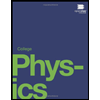 College PhysicsPhysicsISBN:9781938168000Author:Paul Peter Urone, Roger HinrichsPublisher:OpenStax College
College PhysicsPhysicsISBN:9781938168000Author:Paul Peter Urone, Roger HinrichsPublisher:OpenStax College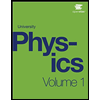 University Physics Volume 1PhysicsISBN:9781938168277Author:William Moebs, Samuel J. Ling, Jeff SannyPublisher:OpenStax - Rice University
University Physics Volume 1PhysicsISBN:9781938168277Author:William Moebs, Samuel J. Ling, Jeff SannyPublisher:OpenStax - Rice University An Introduction to Physical SciencePhysicsISBN:9781305079137Author:James Shipman, Jerry D. Wilson, Charles A. Higgins, Omar TorresPublisher:Cengage Learning
An Introduction to Physical SciencePhysicsISBN:9781305079137Author:James Shipman, Jerry D. Wilson, Charles A. Higgins, Omar TorresPublisher:Cengage Learning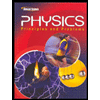 Glencoe Physics: Principles and Problems, Student...PhysicsISBN:9780078807213Author:Paul W. ZitzewitzPublisher:Glencoe/McGraw-Hill
Glencoe Physics: Principles and Problems, Student...PhysicsISBN:9780078807213Author:Paul W. ZitzewitzPublisher:Glencoe/McGraw-Hill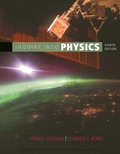
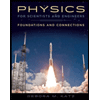 Physics for Scientists and Engineers: Foundations...PhysicsISBN:9781133939146Author:Katz, Debora M.Publisher:Cengage Learning
Physics for Scientists and Engineers: Foundations...PhysicsISBN:9781133939146Author:Katz, Debora M.Publisher:Cengage Learning





